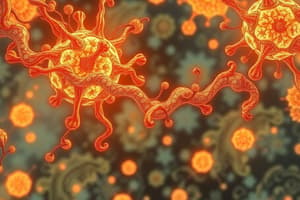Podcast
Questions and Answers
How do enzymes primarily increase the velocity of biochemical reactions?
How do enzymes primarily increase the velocity of biochemical reactions?
- By raising the activation energy required for the reaction
- By stabilizing the transition state of the reaction (correct)
- By increasing the temperature of the reaction environment
- By lowering the concentration of substrate molecules
Which of the following factors does NOT affect enzyme activity?
Which of the following factors does NOT affect enzyme activity?
- pH levels
- Color of the enzyme (correct)
- Substrate concentration
- Enzyme concentration
At what point does increasing substrate concentration no longer increase the reaction velocity?
At what point does increasing substrate concentration no longer increase the reaction velocity?
- When the enzyme denatures
- At the saturation point (correct)
- At the optimal pH
- When an inhibitor is present
What effect does an increase in enzyme concentration have on reaction velocity?
What effect does an increase in enzyme concentration have on reaction velocity?
What type of inhibitor can be removed by dialysis?
What type of inhibitor can be removed by dialysis?
Which statement about competitive inhibition is true?
Which statement about competitive inhibition is true?
Which enzyme is mentioned to have an optimum pH of approximately 2?
Which enzyme is mentioned to have an optimum pH of approximately 2?
What primary role do enzymes serve in biological systems?
What primary role do enzymes serve in biological systems?
What consequence may result from a significant increase in temperature beyond the enzyme's optimal range?
What consequence may result from a significant increase in temperature beyond the enzyme's optimal range?
Which of the following is a characteristic of irreversible inhibitors?
Which of the following is a characteristic of irreversible inhibitors?
Flashcards
What are enzymes?
What are enzymes?
Enzymes are biological catalysts that speed up chemical reactions without being consumed in the process. They lower the activation energy required for reactions to occur.
How do enzymes work?
How do enzymes work?
The activation energy is the minimum amount of energy required for a chemical reaction to occur. Enzymes lower this energy barrier, making the reaction happen faster.
What is 'reaction velocity' in terms of enzymes?
What is 'reaction velocity' in terms of enzymes?
The rate at which an enzyme catalyzes a reaction is known as its reaction velocity. It's essentially how fast the enzyme can work.
How does substrate concentration affect enzyme activity?
How does substrate concentration affect enzyme activity?
Signup and view all the flashcards
How does enzyme concentration affect enzyme activity?
How does enzyme concentration affect enzyme activity?
Signup and view all the flashcards
How does pH influence enzyme activity?
How does pH influence enzyme activity?
Signup and view all the flashcards
How does temperature influence enzyme activity?
How does temperature influence enzyme activity?
Signup and view all the flashcards
What are enzyme inhibitors?
What are enzyme inhibitors?
Signup and view all the flashcards
What are reversible inhibitors?
What are reversible inhibitors?
Signup and view all the flashcards
What are irreversible inhibitors?
What are irreversible inhibitors?
Signup and view all the flashcards
Study Notes
Enzymes 2
- Enzymes are biological catalysts, speeding up reactions in cells.
- Enzymes lower the activation energy required for a reaction to occur.
- Increasing substrate concentration initially increases reaction velocity, but it plateaus because all enzyme molecules are occupied.
- Increasing enzyme concentration increases reaction velocity.
- Factors affecting reaction rate include: substrate concentration, enzyme concentration, pH, temperature, and inhibitors.
Factors Affecting Enzyme Activity
- Substrate Concentration: Increasing substrate concentration speeds up reaction rate initially, until it reaches a saturation point where all enzymes are occupied.
- Enzyme Concentration: Increasing enzyme concentration speeds up the reaction rate.
- pH: Different enzymes have optimal pH values. Extreme pH values can denature enzymes, causing them to lose their shape and function. Pepsin, for example, works best at a very acidic pH (around 2), while most enzymes function best at a neutral pH (around 7).
- Temperature: Enzymes have an optimal temperature for activity. Increasing temperature generally speeds up the rate, up to a point. Beyond this point, the enzyme denatures, and activity slows and stops.
- Inhibitors: Substances that decrease the rate of an enzyme-catalyzed reaction.
Types of Inhibitors
- Reversible Inhibitors: Bind to enzymes through noncovalent bonds. These can often be removed. Examples include drugs and nonpoisons; these can be washed away.
- Irreversible Inhibitors: Bind to enzymes through covalent bonds; these cannot be removed. Examples include poisons like lead and cyanide.
Reversible Inhibitors: Subtypes
- Competitive Inhibitors: Structurally similar to the substrate and bind to the active site.
- Noncompetitive Inhibitors: Do not resemble the substrate and bind to a different site on the enzyme, changing its shape and hence impacting the enzyme's ability to function.
Important Terms
- Allosteric Enzymes: Enzymes whose activity at the catalytic site can be modulated by small molecules (allosteric effectors) binding to a separate site. - Positive allosteric effectors increase enzyme activity. - Negative allosteric effectors decrease enzyme activity.
- Isoenzymes: Enzymes catalyzing the same reaction but having different structures. Lactate dehydrogenase (LDH), creatine kinase (CK), and alkaline phosphatase are examples.
Enzymes as Biological Catalysts
- Most reactions in cells are catalyzed by enzymes. Enzymes are regenerated during the reaction process.
- Enzymes greatly speed up reactions, making them possible at rates compatible with life.
- Enzymes can increase reaction rates by thousands of times.
Studying That Suits You
Use AI to generate personalized quizzes and flashcards to suit your learning preferences.



